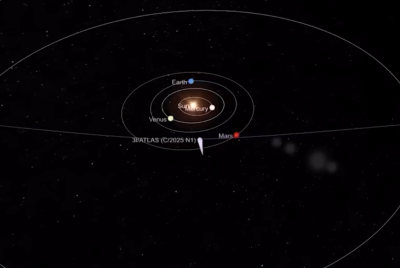3I/ATLAS Is Moving Like A Rock, Then Suddenly Changed — What Caused It?
A new image of 3I/ATLAS reveals behaviour that Harvard's Avi Loeb claims defies natural comet models.

A single photograph, captured deep within the infinite canvas of the cosmos, has ignited a firestorm of debate among the astronomical community. While the universe is full of wandering rocks and frozen debris, occasionally an object appears that refuses to conform to the laws of physics as we understand them.
This is the case with a recent celestial visitor that looks like a comet but acts like something far more mysterious.
The object in question is the interstellar puzzle known as 3I/ATLAS, the third confirmed visitor from another star system after the needle-shaped 1I/'Oumuamua and the rogue comet 2I/Borisov, and a new image has provided fresh ammunition for those who believe we might be looking at something artificial.

The Visual Paradox Of 3I/ATLAS Captured From Earth
On November 22, 2025, at 19:25 UTC, the narrative surrounding this object shifted dramatically. Astrophotographer Mitsunori Tsumura utilised a half-metre telescope to capture a stunning new image of 3I/ATLAS as it passed near the galaxy NGC4454 in projection within the constellation Virgo.
At first glance, the photograph seems to show a standard cometary body: a glowing coma accompanied by two distinct features. These are a tightly collimated tail streaming away from the Sun, and an intriguing anti-tail pointing directly toward it.
However, the scale of these structures is immense. The image depicts 3I/ATLAS at a distance of approximately 300 million kilometres from Earth. Its main tail extends an astonishing 5 million kilometres into the void, while the sunward-pointing anti-tail reaches about 1 million kilometres.
To put that in perspective, at the object's measured speed of 400 metres per second, it would take an entire month to traverse just one million kilometres. While the sheer size is remarkable, what troubles scientists isn't their magnitude—it's the physics required for them to exist at all.

3I/ATLAS And The Physics That Defies Explanation
The existence of the anti-tail is particularly baffling to experts. According to Harvard astrophysicist Avi Loeb's analysis—conducted in his capacity as head of the Galileo Project—the anti-tail's ability to penetrate through the solar wind at that distance demands physics that stretch the boundaries of what we expect from natural comets.
The solar wind at the location of 3I/ATLAS moves at approximately 400 kilometres per second. This is at least one thousand times faster than the thermal speed of gas naturally outflowing from a comet heated by the Sun.
The mechanics at play involve ram pressure, which is the force exerted by moving material pushing against stationary or slower-moving material. Because ram pressure scales with the square of velocity, for the anti-tail to maintain its structure against such a fierce solar wind, its mass density must be extraordinarily high—roughly one million times greater than the density of the solar wind itself, which hovers around a few proton masses per cubic centimetre.
This creates a massive logistical problem for the natural comet theory. If 3I/ATLAS is a natural comet behaving according to known physics, Loeb calculates that it must be losing mass at a staggering rate of approximately 200 tons per second for every square area measuring 0.3 million kilometres on a side, just to account for the anti-tail alone.
When the main tail is included in the calculation, the total mass loss over the months of October and November 2025 reaches several billion tons. That figure represents roughly ten percent of the minimum mass Loeb previously calculated for 3I/ATLAS, which he estimated at 33 billion tons based on the object's lack of non-gravitational acceleration during July, August, and September 2025.

Accelerating Anomalies Of 3I/ATLAS
The mystery deepens when analysing the object's movement. Non-gravitational acceleration occurs when a comet's outgassing creates an uneven thrust, slightly altering its trajectory beyond what gravity alone would dictate. During the summer months, 3I/Atlas showed none. It moved like a rock.
Then something changed. Around perihelion in October 2025, specifically on October 29, when the object made its closest approach to the Sun, a measurable non-gravitational acceleration was detected. JPL Horizons, NASA's authoritative database for solar system object trajectories, now reports this acceleration as statistically significant at ten standard deviations (10-sigma), a level of certainty that leaves little room for measurement error.
The detection is real. The question is what's causing it. For a natural comet, the level of acceleration observed would require more than ten percent of the object's total mass to be expelled as gas and dust, assuming the gas moves at the maximum thermal speed of 400 metres per second. But here's the problem: we've already accounted for roughly ten percent mass loss just to explain the tail and anti-tail structures visible in the images. The math doesn't close.
If 3I/ATLAS is a natural comet, it should have lost more mass than it started with, or it should be far larger than observations suggest. Loeb raises an alternative framework. If the jets propelling 3I/ATLAS are not driven by thermal sublimation of ice but by some form of propulsion technology—chemical thrusters or ion drives—the required mass loss drops dramatically.
Chemical thrusters produce exhaust speeds far higher than thermal gas, reducing the necessary mass loss by two orders of magnitude. Ion thrusters, which accelerate charged particles to even greater velocities, could reduce it by four orders of magnitude.
What The Future Holds For 3I/ATLAS
The visual evidence seems to support the idea that something unusual is happening. The anti-tail is tightly collimated, meaning it doesn't diffuse or spread out as one might expect from randomly outgassing material.
It maintains a coherent beam-like structure pointing sunward. Furthermore, the coma glows with a consistency that indicates sustained activity, not the sporadic bursts typical of comet fragmentation.
Future observations will be critical to solving this riddle. Spectroscopic measurements planned for December 2025 before the closest Earth approach on December 19 could reveal the speed and composition of the jets, distinguishing between natural ice sublimation and alternative mechanisms.
Additionally, tracking will determine whether the object reaches Jupiter's Hill radius on March 16, 2026. Loeb has noted that the object's current trajectory will take it to a distance of exactly 53.5 million kilometres from Jupiter—a figure that precisely matches the planet's gravitational boundary known as the Hill radius.
This gravitational boundary could influence its trajectory in ways that further illuminate its true nature. As the data accumulates, the possibility remains that 3I/ATLAS is either a comet unlike any we've encountered, or it is something we have not yet categorised.
Whether 3I/ATLAS proves to be a freak of nature or a technological visitor, one thing is certain: our understanding of the cosmos is being tested. The coming months promise to uncover the truth behind this interstellar enigma.
© Copyright IBTimes 2025. All rights reserved.




















